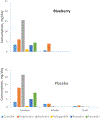Enhanced neural activation with blueberry supplementation in mild cognitive impairment
- PMID: 28221821
- PMCID: PMC6093614
- DOI: 10.1080/1028415X.2017.1287833
Enhanced neural activation with blueberry supplementation in mild cognitive impairment
Abstract
Objectives: Preclinical studies have shown that blueberry supplementation can improve cognitive performance and neural function in aged animals and have identified associations between anthocyanins and such benefits. Preliminary human trials also suggest cognitive improvement in older adults, although direct evidence of enhancement of brain function has not been demonstrated. In this study, we investigated the effect of blueberry supplementation on regional brain activation in older adults at risk for dementia.
Methods: In a randomized, double-blind, placebo-controlled trial we performed pre- and post-intervention functional magnetic resonance imaging during a working memory (WM) task to assess the effect of blueberry supplementation on blood oxygen level-dependent (BOLD) signal in older adults with mild cognitive impairment, a risk condition for dementia.
Results: Following daily supplementation for 16 weeks, blueberry-treated participants exhibited increased BOLD activation in the left pre-central gyrus, left middle frontal gyrus, and left inferior parietal lobe during WM load conditions (corrected P < 0.01). There was no clear indication of WM enhancement associated with blueberry supplementation. Diet records indicated no between-group difference in anthocyanin consumption external to the intervention.
Discussion: These data demonstrate, for the first time, enhanced neural response during WM challenge in blueberry-treated older adults with cognitive decline and are consistent with prior trials showing neurocognitive benefit with blueberry supplementation in this at-risk population.
Keywords: Aging; Blueberries; Brain activation; Dementia; MCI; fMRI.
Figures



References
-
- Albert MS, DeKosky ST, Dickson D, Dubois B, Feldman JJ, Fox NC, Gamst A, et al. The diagnosis of mild cognitive impairment due to Alzheimer’s disease: Recommendations from the National Institute on Aging-Alzheimer’s Association workgroups on diagnostic guidelines for Alzheimer’s disease. Alzheimers Dement. 2011;7:270–279, doi:10.1016/j.jalz.2011.03.008. - DOI - PMC - PubMed
-
- Andres-Lacueva C, Shukitt-Hale B, Galli RL, Jauregut O, Lamuela-Raventos R, Joseph JA. Anthocyanins in aged blueberry-fed rats are found centrally and may enhance memory. Nutr Neurosci 2005; 8:111–120. - PubMed
-
- Shukitt-Hale B, Bielinski DF, Lau FL, Willis LM, Carey AN, Joseph JA. The beneficial effects of berries on cognition, motor behaviour and neuronal function in ageing. Br J Nutr 2015; 114:1542–1549. - PubMed
Publication types
MeSH terms
Substances
Grants and funding
LinkOut - more resources
Full Text Sources
Other Literature Sources
Medical
